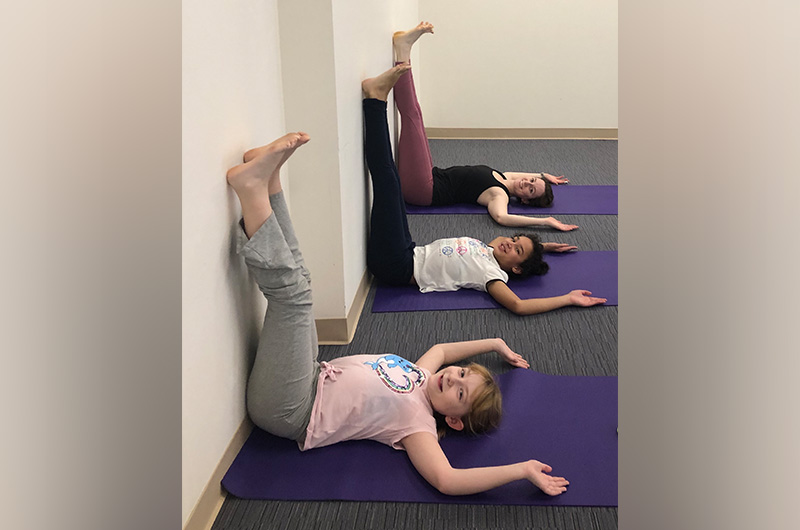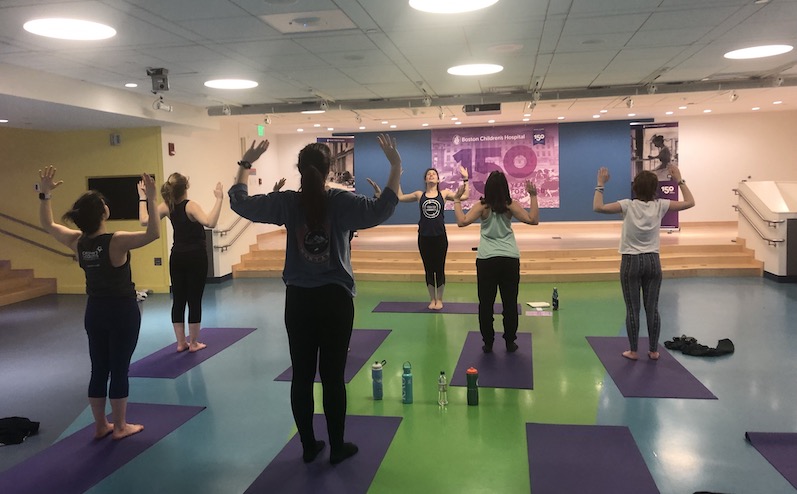Yoga program helps children and teens better manage IBD and stress

In a dimly lit room, about a half dozen teens stand quietly, each trying to balance on one leg. The teacher demonstrates, her other leg bent and knee pointing to the side, forming a flag shape.
This could be a typical yoga class being held just about anywhere in the United States. But the room is actually the Patient Entertainment Center at Boston Children’s Hospital Longwood location. And the participants are patients who have been diagnosed with inflammatory bowel disease (IBD) and are being treated in the hospital’s Inflammatory Bowel Disease Center.
The concept of the class is to help children with IBD understand the mind-body connection and why IBS and stress often go hand-in-hand. The instructors also share strategies to reduce stress associated with flare-ups, according to Jahna Goldmore, a social worker with the IBD Center, which is part of the Division of Gastroenterology, Hepatology, and Nutrition.
Exploring the IBD and stress link
“In recent years, many studies have demonstrated the emotional and physical impact IBD can have on children. Yoga has been shown to improve resiliency and stress management in many children with chronic illness, including IBD,” explains Dr. Lori Zimmerman, a pediatric gastroenterologist at Boston Children’s who has been very involved in the yoga program development. She’s also planning to study the physiological impact of yoga on the young people who participate going forward.
Dr. Zimmerman points out that by educating young people with IBD about their disease and teaching them how they can better manage the symptoms, the hope is that they can feel more in control of their situation. Yoga may also help them overcome some of their common self-confidence challenges.
Creating a yoga program for IBD patients
The idea for the yoga classes came about several years ago when Goldmore and Janis Arnold, clinical director of social work for the Division of Gastroenterology, Hepatology, and Nutrition, recognized that young patients need a positive forum where they could come together with others facing similar challenges. They wanted to explore the idea of using yoga as the framework for the interactions. As fate would have it, two research coordinators they worked with, Tamar Parmet and Julia Green, were also certified yoga instructors and were able to help turn the idea into reality, with some help from the rest of the treatment team.

Now the yoga sessions, which are 90 minutes long, are designed with input from clinicians, social workers, gastroenterologists, and nutritionists. Classes are geared to different ages with themes and material selected to resonate with participants. For instance, for a group of elementary school kids, the instructor challenges participants to imagine they are superheroes, while for high school students, the instructor calls on them to focus on the way IBD impacts their body and to think about how yoga can help mitigate the negative effects.
For all of the age groups, the classes also provide an opportunity for the staff to come in and introduce themselves and explain their role in the IBD Center so the youngsters will feel more comfortable during clinic visits. But Goldmore stresses the real learning happens as participants become more in tune with their bodies and learn how to feel less anxious and more involved in the moment.
Using exercise to manage IBD and stress
“We teach the participants some twisting spinal moves to support digestion, and we provide them with education as to why this helps,” Goldmore says. The yoga portion, which usually lasts an hour, is followed by a 30-minute educational component and icebreakers.
“We aim to ground the experience of the yoga class in some of the science and health benefits,” she says. Conversations can cover topics such as the need to manage IBD and stress or the connection between food and IBD. In addition, the kids and teens have a chance to ask questions.
“We talk about things like, ‘What is stress? And how does yoga change the parasympathetic nervous system?’” she says.

The instructors also encourage the kids to use yoga as a strategy to relax before something stressful, like a blood test or something else they are worried about.
At the end of each class, the instructor asks participants how they feel. The answers include: calm, peaceful, and energetic. These are all feelings they can call on during stressful times to help them relax long after yoga is over.
“We want to help kids to build on what they learn in our classes so they can use it throughout the course of their days,” Goldmore says, adding, “We are looking forward to continuing to develop programs that address patient needs. We are also holding a five-session group for teens in the spring.”
For more information about upcoming yoga classes, email IBDwellness@childrens.harvard.edu.
Learn more about the IBD Center.
Note: Since the onset of the COVID-19 pandemic, this program has evolved to support children and teens at home since group exercise is not recommended at this time.
Related Posts :
-

‘The reason I became a nurse’: Maeve’s memories of laryngeal cleft repair
Being a gastroenterology nurse is more than a profession for Maeve Lee. When she cares for patients with feeding tubes, ...
-

A journey through the intestine during colitis, cell by cell
Inflammatory bowel disease (IBD), causing devastating abdominal pain, persistent diarrhea, and rectal bleeding, is hard to control with current treatments. ...
-

‘Everything fell into place’: Innovative POEM procedure lets Peyton eat without pain
Peyton Reed, 14, is a typical teenage boy: He enjoys tennis, video games — and food. So when eating became so painful ...
-

Microvillus inclusion disease: From organoids to new treatments
Microvillus inclusion disease (MVID) is a rare type of congenital enteropathy in infants that causes devastating diarrhea and an inability ...




